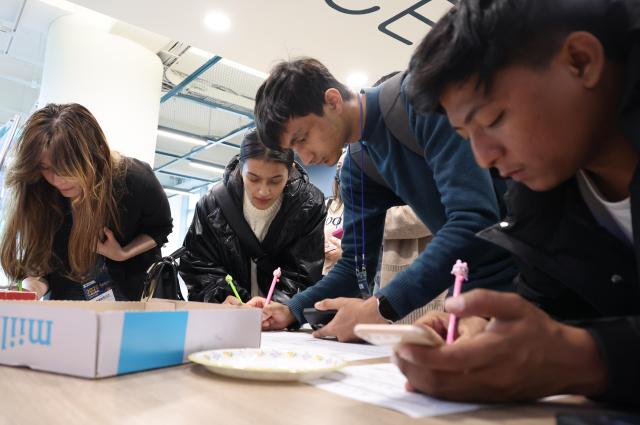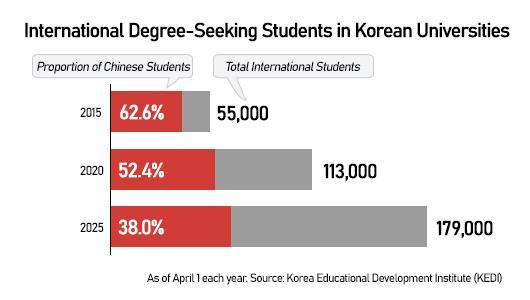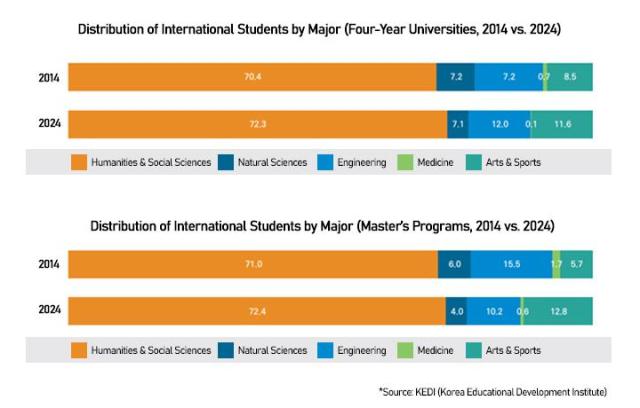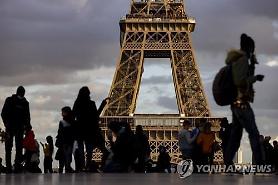
SEOUL, November 24 (AJP) - Non-Chinese students now make up the majority of foreign enrollment at Korean universities, as the number of international degree-seekers has tripled over the past decade. Foreign students also fill one in every six postgraduate seats — a striking figure for a country facing a shrinking workforce and rising demand for highly skilled talent.
According to the Korea Educational Development Institute (KEDI), 179,190 international students were enrolled in degree programs at Korean universities and two-year colleges as of April, a 3.2-fold jump from 55,739 in 2015.
A decade ago, Chinese students accounted for more than 60 percent of all foreign degree-seekers. This year, their share has fallen to 38 percent (68,045 students), even though their absolute numbers nearly doubled over ten years. The shift reflects an explosive rise in students from elsewhere: Vietnam ranked second with 40,865 students, followed by Uzbekistan (14,318), Nepal (12,626) and Mongolia (10,570). Vietnam alone added nearly 10,000 new students in a single year.

One notable trend is the growing number of foreign students majoring in humanities, social sciences, and the arts, particularly at the doctoral level — a phenomenon widely linked to the global popularity of K-pop, K-dramas, and Korean film.
But this diversification masks a critical gap: Korea still struggles to attract students in natural sciences, engineering, high-tech fields and regional manufacturing. Enrollment in these areas has grown only marginally, and the overall share has fallen over the past decade. The number of engineering students at the master's and doctoral levels increased by only around 1,000 during the same period — far too small to ease shortages in semiconductors, batteries, mobility, and industrial R&D.

Vu Giang Thanh, a 26-year-old Vietnamese graduate of Seoul National University of Science and Technology, told AJP that most international students come to Korea with two main goals: experiencing a global learning environment and earning more than they could at home while studying.
"Korea's cultural familiarity and relatively accessible admission policies are appealing," she said. "But most students I know aren't here to build long-term careers. They come for the experience and financial benefits — and leave after five to seven years."
Regional universities face an additional challenge. They continue to receive a high proportion of non-degree students on short-term programs, limiting both local retention and the creation of a stable talent pool for regional industries.
"As competition intensifies globally for skilled workers, Korea needs policies that support foreign graduate-level students at every stage — recruitment, study, employment, and settlement," said Choi Jung-yoon, senior researcher at KEDI. "Simply expanding headcounts won’t solve regional workforce shortages."
She emphasized the need for a data-based policy evaluation system, with periodic goal-setting and analysis of foreign students’ characteristics and needs at each stage.
Japan is a key reference point. After launching a "100,000-student plan" in the 1980s and a "300,000-student plan" in 2008, the country hit its 300,000 target early in 2019. It is now pursuing a 400,000-student plan for 2023 to 2033, shifting focus from quantity to high-quality talent positioned to contribute to economic development.
A notable feature of Japan's approach is multi-ministry coordination — with education, justice, foreign affairs, labor and others jointly managing admissions, immigration, campus support, employment pathways, and long-term settlement. Regional universities, particularly in Osaka and the northeast, are also building program strengths aligned with local industries.
Gunma University, for example, promotes local settlement through internships tied directly to regional economic needs. The contrast with Korea is clear: more than 60 percent of foreign students in Korea want to work in Seoul regardless of where they studied. Meanwhile, 89 of Korea's 226 municipalities — nearly 40 percent — are officially designated as depopulating regions.
Korea introduced the F-2-R visa last year, allowing foreign graduates to gain residency if they work in depopulating regions. The visa offers long-term stay, family accompaniment, and fewer job restrictions.
"Local governments' economic plans and industry demand must be directly tied to foreign student recruitment," said a researcher at the Korea Migration Research and Training Center. "Key industries should be matched with relevant academic departments at nearby universities. Otherwise, neither local industries nor universities can gain real momentum."
Copyright ⓒ Aju Press All rights reserved.


![[OPINION] My first impression in Seoul: a foreigners perspective](https://image.ajunews.com/content/image/2018/05/29/20180529102122902848_278_163.jpg)
